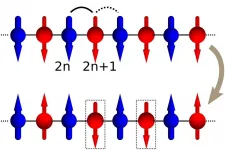(Press-News.org) In a new study out of University of California San Diego School of Medicine, researchers have identified a universal strain of bacteria derived from healthy human skin that can treat the most common type of eczema, also known as atopic dermatitis.
In the paper published Feb. 22, 2021, in Nature Medicine, the research team investigated the safety and mechanisms of this certain bacteria in a first-in-human, Phase I, double-blinded clinical trial looking to treat people living with eczema. Of the 54 participants, two-thirds reported improvements in their symptoms, including fewer complaints of itchiness and inflammation.
"The main question we wanted to answer was if this was safe. This was a safety study," said Richard Gallo, MD, PhD, Ima Gigli Distinguished Professor of Dermatology and chair of the Department of Dermatology at UC San Diego School of Medicine. "We found exactly what we hoped to find. The eczema of participants who received the bacterial treatment improved and there were no adverse events."
Researchers screened more than 8,000 isolates of Staphylococcal bacteria derived from the skin of individuals without eczema, and identified a few strains that inhibited growth of Staphylococcal aureus, a pathogenic bacterium that aggravates skin conditions, such as eczema. These strains were evaluated for additional characteristics, such as decreased capacity to damage skin, and sensitivity to common antibiotics.
The screening resulted in the identification of a single strain of bacteria called Staphylococcus hominis A9 that could be used for the treatment of atopic dermatitis.
"That's how we found the universal strain. This was one out of 8,000 strains that were tested in a dish for their ability to kill Staphylococcal aureus and treat atopic dermatitis," said Gallo. "And it worked."
The first tests were performed in animal models where mice were given an experimental version of eczema. Researchers then mixed Staphylococcus hominis with unscented lotion and applied the mixture to the mice twice daily for three days. After treatment, also known as bacteriotherapy, the mice were essentially cured of the eczema.
Success with these animal models led to the Phase I clinical trial using bacteriotherapy to treat 54 trial participants with eczema. Two-thirds of the participants showed a large reduction in S. aureus populations on their skin and improvement in their eczema.
"This research is a unique approach to targeting the harmful Staphylococcal aureus on atopic dermatitis skin with beneficial bacteria," said study co-author Donald Leung, MD, allergist and immunologist at National Jewish Health and a co-author of the study. "It's our hope this will help patients with eczema rid their skin of the harmful bacteria causing the inflammation. Future studies will determine if this new cream can be used for long periods' of time to reduce the severity of eczema and improve the patient's quality of life."
Healthy human skin is alive with bacteria -- there are more microorganisms living in and on the human body than there are human cells. Most microbes reside on human skin without causing harm, but in some people, bacterial pathogens can negatively alter a person's health.
According to the National Eczema Association, nearly 18 million people in the United States have atopic dermatitis, the most common form of eczema, which is a chronic, itchy rash that commonly appears on the arms, legs and cheeks.
"From our research, we've determined this rational therapeutic approach for atopic dermatitis appears to be safe for people to use to treat their eczema," said Gallo. "And it's easy, too, because it's just a cream and avoids the side effects of steroids and other drugs that target the immune system."
INFORMATION:
Co-authors of the study include: Teruaki Nakatsuji, Tissa R. Hata, Yun Tong, Joyce Y. Cheng, Faiza Shafiq, Anna M. Butcher, Secilia S. Salem, Samantha L. Brinton, UC San Diego; Amanda K. Rudman Spergel, National Institutes of Health; Keli Johnson, Brett Jepson, Agustin Calatroni, Gloria David, Rho Federal Systems Division, Inc.; Marco Ramirez-Gama, and Patricia Taylor, National Jewish Health.
Disclosure: Richard L. Gallo is a cofounder, consultant, member of the scientific advisory board and holds equity in MatriSys Bioscience, a company that is developing skin bacteriotherapy.
The diversity and numbers of wild salmon in Northern B.C. have declined approximately 70 per cent over the past century, according to a new Simon Fraser University study.
Researchers drawing on 100-year-old salmon scales report that recent numbers of wild adult sockeye salmon returning to the Skeena River are 70 per cent lower than 100 years ago. Wild salmon diversity in the Skeena watershed has similarly declined by 70 per cent over the last century.
The research undertaken by Simon Fraser University (SFU) and Fisheries and Oceans Canada was published today in the Journal of Applied Ecology.
The research team applied modern genetic tools to salmon scales collected from commercial ...
Boston, Mass. - Even with more than 1.5 million Americans receiving a COVID vaccine each day, officials estimate it will take many more months before enough people are protected from the deadly virus. Until then, and potentially beyond, experts agree that opening up schools, restaurants and other public places as safely as possible will rely on widespread testing for SARS-CoV-2, the virus that causes COVID-19.
As of June 2020, the U.S. Food and Drug Administration (FDA) had granted emergency use authorization for more than 85 different viral DNA test kits -- or assays -- each with widely varying degrees of sensitivity and unknown rates of accuracy. However, with no existing gold standard test for the novel coronavirus, there's little data on which ...
A paper recently published in the scientific journal Stem Cells and Development shares an important advancement in conservation -- one that may make the difference between survival and extinction for wildlife species that have been reduced to very small population sizes. Using fibroblast cells that have been preserved in San Diego Zoo Global's Frozen Zoo®, scientists have been able to generate induced pluripotent stem cells of northern and southern white rhinoceroses. This important breakthrough is the first step in a complex process for generating gametes from deceased and non-reproductive individuals of these two subspecies.
"For the northern white rhino, which is functionally extinct, the only hope for survival may be in the ...
ITHACA, N.Y. - Cornell University scientists have identified a new contender when it comes to quantum materials for computing and low-temperature electronics.
Using nitride-based materials, the researchers created a material structure that simultaneously exhibits superconductivity - in which electrical resistance vanishes completely - and the quantum Hall effect, which produces resistance with extreme precision when a magnetic field is applied.
"This is a beautiful marriage of the two things we know, at the microscale, that give electrons the most startling ...
LOS ALAMOS, N.M., Feb. 22, 2021--A team of quantum theorists seeking to cure a basic problem with quantum annealing computers--they have to run at a relatively slow pace to operate properly--found something intriguing instead. While probing how quantum annealers perform when operated faster than desired, the team unexpectedly discovered a new effect that may account for the imbalanced distribution of matter and antimatter in the universe and a novel approach to separating isotopes.
"Although our discovery did not the cure the annealing time restriction, it brought a class of new physics problems that can now be studied with quantum annealers without requiring they be too slow," said Nikolai Sinitsyn, a theoretical physicist at Los Alamos National ...
HOUSTON - (Feb. 22, 2021) - Governments with strong female representation are more likely to deliver on campaign promises, according to new research from Rice University.
"The Effects of Women's Descriptive Representation on Government Behavior" by author Jonathan Homola, an assistant professor of political science at Rice, examines campaign promises and subsequent policymaking by parties in power in 10 European countries, the United States and Canada along with data on women in party leadership and elected offices.
The study also showed that promises are even more likely to be kept when women in government assume leadership roles.
Homola said the research demonstrates the importance of women playing part in the ...
Researchers at the Center for Advanced Bioenergy and Bioproducts Innovation (CABBI) found that transitioning land enrolled in the Conservation Reserve Program (CRP) to bioenergy agriculture can be advantageous for American landowners, the government, and the environment.
Land enrolled in the CRP cannot currently be used for bioenergy crop production, wherein high-yielding plants (like miscanthus and switchgrass) are harvested for conversion into marketable bioproducts that displace fossil fuel- and coal-based energy. Established by the U.S. Department of Agriculture in 1985, the CRP incentivizes landowners to retire environmentally ...
A new study by an international team of researchers found that adults with Down syndrome are more likely to die from COVID-19 than the general population, supporting the need to prioritize vaccinating people with the genetic disorder.
Investigators found that adults with Down syndrome were roughly three times more likely to die from COVID-19 than the general population. This increased risk was especially apparent in from fifth decade of life: A 40-year-old with Down syndrome had a similar risk of dying from COVID-19 as someone 30 years older in the general population.
The study was published this week in The Lancet's ...
Strokes are a leading cause of poor quality of life or even death in Japan and the world over. Since its characterization, several researchers have been working tooth and nail to identify drug-accessible and effective therapeutic targets for this debilitating condition. One such region of interest for drug targets is the blood-brain barrier (BBB).
The BBB is a structure located around the brain, which prevents the entry of unnecessary circulating cells and biomolecules into the brain. The blood vessels in the BBB are coated with a distinct and protective layer of sugar, called the endothelial glycocalyx, which prevents their entry. However, in the event of a stroke, which results in the blockage or severance of blood vessels in the brain, studies have shown that this ...
Skoltech researchers have designed a software-based algorithm for synchronizing time across smartphones that can be used in practical tasks requiring simultaneous measurements. This algorithm can essentially help turn several devices into a full-fledged network of sensors. The paper was published in the journal Sensors.
If you want a network of intelligent devices - say, an array of cameras capturing a dynamic scene or another kind of network of sensors - to work properly, one of the fundamental tasks you have to solve is clock synchronization: all devices should have the same timeline, often up to sub-millisecond for the more challenging tasks. Modern smartphones can easily be used as multipurpose ...



